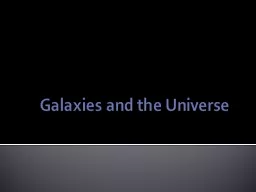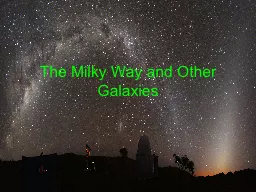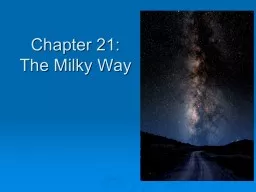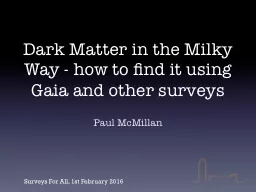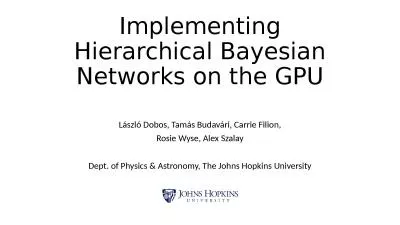PPT-The Milky Way
Author : faustina-dinatale | Published Date : 2017-05-18
The Milky Way Our Home Galaxy What are the different components of the Milky Way How do we see those components What does a map of each component look like from
Presentation Embed Code
Download Presentation
Download Presentation The PPT/PDF document "The Milky Way" is the property of its rightful owner. Permission is granted to download and print the materials on this website for personal, non-commercial use only, and to display it on your personal computer provided you do not modify the materials and that you retain all copyright notices contained in the materials. By downloading content from our website, you accept the terms of this agreement.
The Milky Way: Transcript
The Milky Way Our Home Galaxy What are the different components of the Milky Way How do we see those components What does a map of each component look like from our point of view Stars in the Milky Way. (Resolved by Galileo). Milky Way:. Galactic Structure and Dynamics. Milky Way has spiral structure. . Galactic Bulge surrounds the Center. . Powerful radio source Sagittarius A at Center. C. ontains Super-Massive Black Hole . The Milky Way Galaxy. When you look into the hazy band of light across the sky, you are actually looking at our galaxy from the inside. While an awesome sight, you can only truly begin to see it if you get away from city lights on a moonless night. . Recap. Canvas homework: due on Wednesday. Lab this week: Galaxy Morphology. Campus Observatory. Milky Way galaxy. Stars: . brightnesses. , masses, sizes, compositions, evolution. Interstellar matter: gas, dust. Galaxy. part 2. Unit: . Galaxies. Star systems like our Milky Way. Contain a few thousand to tens of billions of stars.. Large variety of shapes and sizes. Galaxy Diversity. The Hubble Deep Field:. William Herschel’s map of the Milky Way based on star counts. In the early 1800’s William Herschel, the man who discovered the planet Uranus, tried to understand the shape of the Milky Way by counting stars. He counted how many stars there were in each of dozens of different directions and then plotted the count versus direction. . Paul McMillan. Surveys For All, 1st February 2016 . Why do we care?. On the biggest scales, the ΛCDM model works. Why do we care?. On the scale of individual galaxies, agreement is less obvious.. Things are more complicated, we have to consider the baryons. . Loners. Interactions were once . believed to be unimportant . and rare.. Galaxies were thought to . be . isolated loners. , well . separated from one . another . a. nd scarcely interacting.. Au Contraire!. Spiral Structure. . The Astronomical Context. By the 1920’s, we knew that the once-mysterious spiral nebulae were flattened galaxies. . Our Milky . Way is . also. flattened. . Two obvious . questions arose:. bye:. Angelina Battle. The legend of The Milky Way. This is what old people told me when I was a child. Long ago, when the world was new, there were not many stars in the sky. In those days people depended on corn for their food. They would grind it and keep it in bins behind their homes. Bread made from cornmeal, often kept them from starving during the long winter months. . Contains more than 100 billion stars. Is one of the two largest among 40 galaxies in the Local Group. Our Solar System is located a little more than half way from the galactic center to the edge of the galactic disk.. Neoplatonist. philosopher . Olympiodorus. the Younger (c. 495–570 AD) criticized this view, arguing that if the Milky Way were sublunary it should appear different at different times and places on the Earth, and that it should have parallax, which it does not. In his view, the Milky Way was celestial. This idea would be influential later in the Islamic world.. The astonishing variety of galaxies derived from a few structural types. Sec 1.3. Irregulars. = misfits in any class. Edwin Hubble . The Realm of the Nebulae . (1936. ). ‘. Tuning Fork’ classification scheme of galaxies. David Spergel. What has changed?. Context:. Standard cosmological model. No galaxy is an island… (John Dunne vs. Immanuel Kant). Tools:. Statistical galactic astronomy. 100s of stars -> 100,000s -> 1e9 (GAIA +LSST). László Dobos, Tamás Budavári, Carrie Filion,. Rosie. Wyse, Alex Szalay. Dept. . of . Physics. & . Astronomy. , The . Johns. Hopkins University. Subaru . Prime. . Focus. . Spectrograph. Manua.
Download Document
Here is the link to download the presentation.
"The Milky Way"The content belongs to its owner. You may download and print it for personal use, without modification, and keep all copyright notices. By downloading, you agree to these terms.
Related Documents


